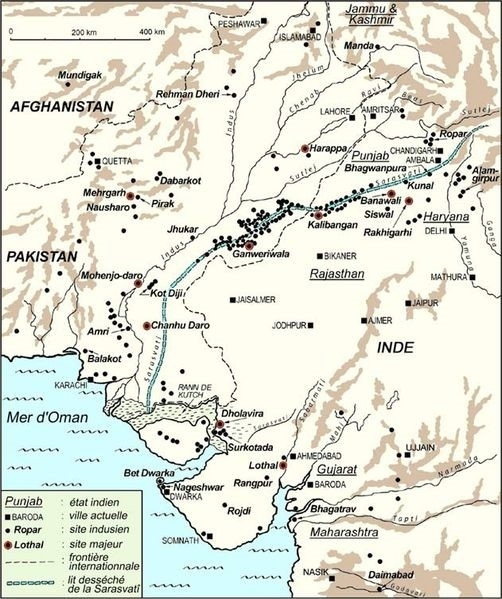ALL YOU WANT TO KNOW ABOUT ONE OF THE MOST ANCIENT CIVILIZATIONS:#INDUS VALLEY CIVILIZATION.Civilization flourished between 2500 BC-1750 BC.
INDUS VALLEY CIVILIZATION
John Marshall, the first scholar to use the term “Indus valley civilization”. The civilization flourished between 2500 BC-1750 BC.
Geographical Extent of IVC
1. Extent: The Indus valley civilization extended from Sutkagandor (in Baluchistan) in the West to Alamgirpur (Western UP) in the East; and from Mandu (Jammu) in the North to Daimabad (Ahmednagar, Maharashtra) in the South.

Image source: NCERT
2. Important cities
City | River | Archaeological Importance |
Harappa (Pakistan) | Ravi | A row of 6 Granaries, Mother goddess figurines |
Mohenjodaro (Pakistan) | Indus | Great Granary, Great bath, Image of Pashupati Mahadeva, Image of Bearded man and Bronze image of a woman dancer |
Lothal (Gujarat) | Bhogava | Port city, Double burial, Terracotta horse figurines. |
Chanhudaro (Pakistan) | Indus | The city without a citadel |
Dholavira (Gujarat) | Indus | City divided into 3 parts. |
Kalibangan (Rajasthan) | Ghaggar | Ploughed field |
Banawali (Haryana) | Ghaggar | - |
Rakhigarhi (Haryana) | - | - |
Ropar (Haryana) | ||
Mitathal (Haryana) | - | - |
Bhagatrav (Gujarat) | - | - |
Rangpur (Gujarat) | - | - |
Sutkagandor (Pakistan) | - | - |
Sukotada (Gujarat) | - | - |
Kot Diji (Pakistan) |
Town planning and Structure of IVC
- Grid system(Chess-board) of town planning
- Rectangular houses with brick-lined bathrooms and wells together with stairways are found
- Use of Burnt bricks
- Underground drainage system
- Fortified citadel
Agriculture of Indus Valley Civilisation
- Hindon – Cotton – Major trade good – earliest people to produce Cotton.
- Proofs of Rice husk found
- Wheat and Barley were majorly cultivated
- Use of wooden ploughshare. They had no idea about Iron implements.
Domestication of animals
- Ox, Buffalo, Goats, Sheep and Pigs were domesticated
- Asses and camels were used as Beasts of Burden
- Elephants and Rhino were known
- Remains of horse found in Surkotada and evidence of horse in Mohenjodaro and Lothal are also found. But the civilization was not horse-centred.
Technology and crafts
- Bronze (Copper + tin) tools widely used
- Stone implements were still in vogue
- Potter’s wheel was put to full use
- Bronzesmiths, Goldsmiths, Boat-Making, Brick-laying etc were other occupations commonly found
Trade of Indus Valley Civilisation
- Presence of granaries, weights and measures, seals and uniform script signifies the importance of trade
- The barter system was widely prevalent
- Lothal, Sutkagendor were port cities used for conducting trade
- Trade destinations – Afghanistan, Iran and Central Asia. Contacts with Mesopotamia civilization are also seen
The political organization of IVC
- Cultural homogeneity achieved through a strong central authority
- No temples or religious structures found. Harappa was possibly ruled by Merchants class.
- Weapons are rarely found.
Religious practices of IVC
- Terracotta figure of Mother Goddess.
- Phallu and Yoni worship.
- Pashupati Mahadev seal found with the elephant, tiger, rhino and a bull surrounding him with two deer near his feet.
Tree and animal worship of IVC
- Pipal tree worship was found.
- One-horned Unicorn recognized as Rhino and the humped bull was commonly worshipped.
- Use of Amulets to ward off ghosts and evil spirits.
- The lion was not known in Harappan culture.
The Harappan script
- Harappan script Pictographic in nature but not deciphered so far.
- They are recorded on seals and contains only a few words
- Harappan Script is the oldest script in Indian Sub-continent
Weights and Measures
- Use of standardized weights and measures to keep accounts of private property, to indulge in trade and commerce etc.
- Weights are found in multiples of 16.
Harappan Pottery of IVC
- Well-developed Pottery techniques with elaborate designs of trees and circles.
- Redware pottery painted with black designs.
Seals of Indus Valley Civilisation
- Seals were used for the purpose of trade or worship. Images of animals such as Buffalo, bull, tiger etc were found inscribed in the seals
Statue of IVC
- Discovery of Bronze statue of a naked woman and bearded man steatite statue
Terracotta figurines of IVC
- Terracotta – Fire baked earthen clay
- Used as toys or objects of worship
- Massive stone works were not found in Harappa which shows the poorly developed artistic works made of stone
Origin, maturity and end of IVC
- Pre-Harappan Settlements – Lower Sindh, Baluchistan and Kalibangan.
- Mature Harappa – 1900BC – 2550BC.
- Causes for the Decline of Civilization.
- Decreasing fertility due to increasing salinity on the account of the expansion of the nearby desert.
- Sudden subsidence of uplift of land causing floods.
- Earthquakes caused changes in the course of Indus.
- Twitter account of pm modi hacked:–
- https://medium.com/@yoyoop7688/twitter-account-of-pm-modis-personal-website-hacked-investigation-is-going-on-eb0891ec8fbb
Post-urban Phase (1900BC – 1200BC)
- Sub-Indus Culture
- Primarily chalcolithic
- Development of Ahar Culture, Malwa Culture and Jorwe Culture at various phases in post-Harappan Civilization.




टिप्पणियाँ
एक टिप्पणी भेजें